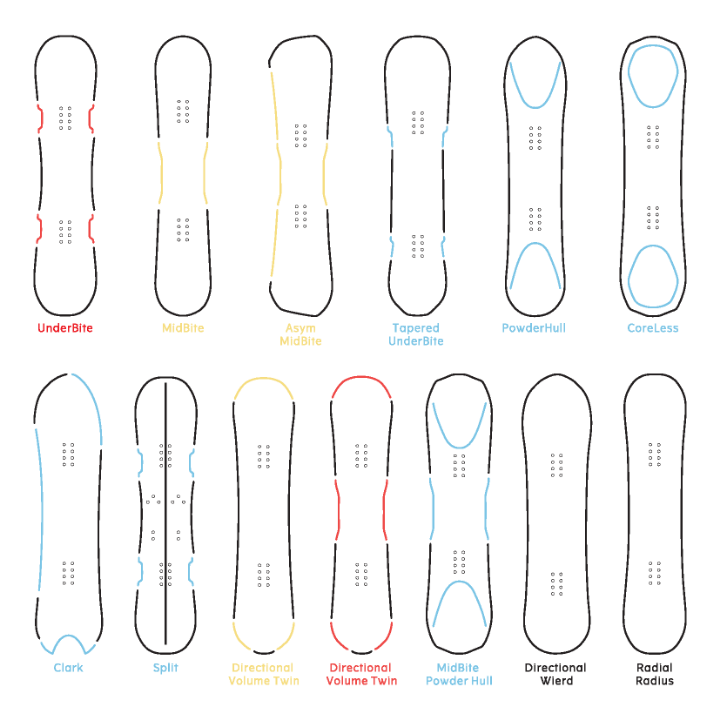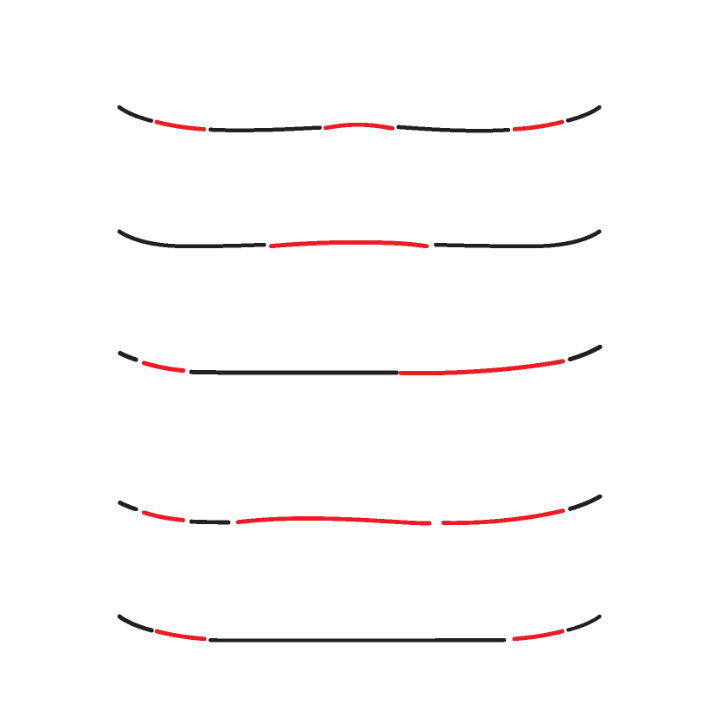YES.
It's a decimeter squared:DM²: Get to know your numbers.
Surface area matters more than length. Ever since designing the 420 and proving that width can provide the stability and floatation traditionally associated with length, we've been on a treadmill of wordy explanations. Now we quantify it. Similar to how surfboards use volume as a key metric in board selection, surface area will change the way snowboarders select a board. Surface area is measured in square decimeters: DM². Matching your weight and ability to your dm² will better guide you in this wonderful world of eclectic shapes and sizes available to the modern shredder.
Tighter turns and stable landings
MidBite blends the response of a narrow waist width with the stability of a wider nose & tail.
The design steps a single section of each sidecut inward between the insert packs. This single, long indention of the sidecut between the bindings creates a narrower waist width, providing quicker edge-to-edge response. Meanwhile, from your bindings out to the end of the sidecut, we maintain a wider board width that improves float in pow and is a stable platform for popping, spinning and landing on any snow type.
VS UnderBite: The narrower waist gives you more versatile turns and increased stability in the nose and tail. But you have fewer insertion points so less edge hold on hard-packed snow.
Correcting the difference between toe and heel edge power.
We do not have the same leg power when turning on a heel edge as we do on a toe edge turn, but an asymmetrical edge profile can equalize turning power to create symmetrical turns. By providing a smaller radius and shorter and deeper MidBite zone on the heel edge versus the toe edge, you are able to get more powerful heelside turns with less rider effort, leading to a natural and intuitive feel when riding.
Better edge hold and easier turns.
By indenting the edge under the feet a couple of millimeters, UnderBite acts as a serrated knife, redistributing rider weight and input power. This creates more leverage over the edges of the board for easier turn initiation, better edge hold, greater control, and smoother turns.
VS MideBite: UnderBite gives you more drive in your turns because you have 2 insertion points under your feet, but you don't benefit from the narrower waist in the turn.
More floatation and total edge control
Similar in appearance to "wings" on a surfboard, Tapered UnderBite functions a little differently on snow. Each side of the board's effective edge is segmented into 3 distinct parts that step horizontally inward rather than tapering.
Traditional tapered boards reduce the volume in the tail by taking the full sidecut and pulling the tail inward, or away from the arc of the turn, which can wash out while carving hard.
Tapered UnderBite increases the sidecut depth by stepping in at each insert pack to create additional contact points and keep the edge engaged all the way through the end of a turn. The Tapered UnderBite gives boards all the float of traditional taper and all the power and drive of a traditional sidecut.
VS UnderBite: The Tapered UnderBite adds floatability to the board, but does not ride switch as well as the tail (new nose) will tend to sink.
93% of fresh snow is air. No water.
Reference : National Snow and Ice Data Center, 2019.
The YES. PowderHull understands that 93% of powder is air. The design innovation itself comes from the study of how air moves and reacts below a snowboard.
The deep concaves that characterize the unique PowderHull profile service two functions :
1/ The leading concave on the nose acts like a mouth and pulls in air below the nose, building up an air cushion to keep the nose afloat.
2/ The tail concave acts in the same way as a tired-and-tested swallowtail, quickly releasing air and allowing the tail to drop effortlessly. The PowderHull creates a stiffer platform than a swallowtail, providing more stability in tight turns.
Lighter swing weight and better floatation
CoreLess tech allows for lighter swing weight for a more nimble ride and more refined base contours to maximize float in pow. In the past, removing portions of wood core and replacing it with foam or honeycomb materials lead to these materials filling up with resin or causing bonding issues. These materials combined with resin defeated the purpose as it was heavier than wood. Removing the wood removed some bulk, and using resin without an additional core material allowed us to increase the weight savings. Adjusting the structure of the surrounding core profile allowed us to maintain optimal strength/flex ratios. Beyond weight savings, removing the wood core allowed us to create the PowderHull shape because without the molding limitations of wood we were able to create a more refined base contour to achieve the performance we were after. CoreLess tech combined with MidBite becomes the perfect blend for a backcountry freestyle board.
Technology Explained :
MidBite PowderHull:Adding even more float by giving the PowderHull or CoreLess boards a MidBite radius gives that extra bite to the board when riding hardpack and allows for tighter turns on the groomers. Once in powder, you are virtually unsinkable with the combination of the PowderHull and MidBite.
Radial Radius:When basics are good, a radial edge is the classic snowboard sidecut, where the radius draws a single circle. It's the most basic way to turn, it will allow you to carve but you are limited in the variations of turns you can make.
Directional Weird:This is all about surface area displacement to create float and stability. The shorter length, increased surface area, and tighter turning radius are ideal for forested powder runs.
Directional Volume Twin:Hiding surface area to enhance floatation. By pulling the radius of the nose up towards the tip we add some dm2 into the area that impacts floatation, creating a bigger nose. This neither influences the turning radius nor the waist width and therefore creates a board that performs like a twin while having the hidden surface area of a powder board. The best of both worlds.
Clark:You are the master of the technology here. Use your creative mind to build the perfect board. Make sure you seal the wood with a varnish after you've taken the jigsaw to it. This board has all the radii you want to have.

Technology Explained :
Camrock:The response of camber with the floatability of rocker. By combining camber and rocker you allow the board to be both responsive and floaty. Camber between the feet acts as a spring keeping the contact points on the ground throughout the turn for better edge hold. Once compressed the camber will accentuate the rocker and lift the nose out more allowing it to float.
Camber:Camber is the base of snowboarding: you need to have an edge hold enough to drive in and out of turns, the Camber acts as a shock absorber on cars they push the wheels into the road to enhance grip. The camber does exactly that to the edge. Allowing you to drive your turns longer and release later.
Blended Rocker:Our blended rocker is a mix of flat board profile and a rocker which gives you the forgiveness you want from a kids’ board, the flat section keeps the board from being too aggressive and the rocker segment avoids the nose catching an edge. This gives the board a lot of forgiveness and allows your kid to learn the easy way - minimizing the scorpions.
Blended Camrock:We added some rocker on directional boards making the camrock profile more directional. With a higher rocker on the nose of the board, it drives the nose up as you ride powder and with the camber set back a little, you have a longer rocker nose making it float like crazy.
Flatrock:This is to make kids’ boards versatile and forgiving. The board will allow you to do anything but will not be aggressive nor will it be challenging to the ride. It's truly a profile meant to make snowboarding easy to learn.

